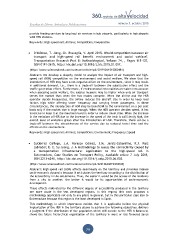Page 81 - 360AV03
P. 81
Reseñas de Libros, Artículos y Publicaciones número 3. octubre 2015
provide feeding services to long haul air services in hub airports, particularly in hub airports
with HRS stations.
Keywords: High-speed rail; Airlines; Competition; Cooperation
D’Alfonso, T. Jiang, Ch. Bracaglia, V. April 2015. Would competition between air
transport and high-speed rail benefit environment and social welfare?,
Transportation Research Part B: Methodological, Volume 74, , Pages 118-137,
ISSN 0191-2615, http://dx.doi.org/10.1016/j.trb.2015.01.007.
(http://www.sciencedirect.com/science/article/pii/S0191261515000181)
Abstract: We develop a duopoly model to analyze the impact of air transport and high-
speed rail (HSR) competition on the environment and social welfare. We show that the
introduction of HSR may have a net negative effect on the environment, since it may result
in additional demand, i.e., there is a trade-off between the substitution effect and the
traffic generation effect. Furthermore, if environmental externalities are taken into account
when assessing social welfare, the surplus measure may be higher when only air transport
serves the market than when the two modes compete. When the airline and the HSR
operator decide frequencies, the airline reduces the aircraft size in order to keep load
factors high while offering lower frequency and carrying fewer passengers. In these
circumstances, the introduction of HSR may be beneficial to the environment on a per seat
basis only if the market size is large enough. When the HSR operator decides speed, it has
incentive to keep it at the maximum level in order to reduce travel time. When the increase
in the emissions of HSR due to the increase in the speed of the train is sufficiently high, the
overall level of emissions grows after the introduction of HSR. Therefore, there can be a
trade-off between the attractiveness of the service due to reduced travel time and the
effects on the environment.
Keywords: High-speed rail; Airlines; Competition; Environment; Frequency; Speed
Gutiérrez Gallego, J.A. Naranjo Gómez, J.M. Jaraíz-Cabanillas, F.J. Ruiz
Labrador, E. E. Su Jeong, J. A methodology to assess the connectivity caused by
a transportation infrastructure: Application to the high-speed rail in
Extremadura, Case Studies on Transport Policy, Available online 7 July 2015,
ISSN 2213-624X, http://dx.doi.org/10.1016/j.cstp.2015.06.003.
(http://www.sciencedirect.com/science/article/pii/S2213624X15300043)
Abstract: High-speed rail (HSR) affects enormously on the territory and provokes intense
socio-economic dynamics because it articulates the territory according to the distribution of
the accessibility in the settlements. Thus, the easier it would be the access of the residents
from a city to another, the better it would be its opportunities of socio-economic
development.
These effects motivated by the different degree of accessibility produced in the territory
are more acute in the less developed regions. In this regard, this work proposes a
methodology applicable not only to any place in general, but in this particular case also to
Extremadura because this region is the least developed in Spain.
This methodology in which importance resides that it is applicable before the physical
implantation of the HSR in the territory allows to achieve the following objectives: delivers
a judgment if the distribution of the population which will accede to the HSR is balanced,
shows the future hierarchical organization of the territory in more or less favoured zones
79

